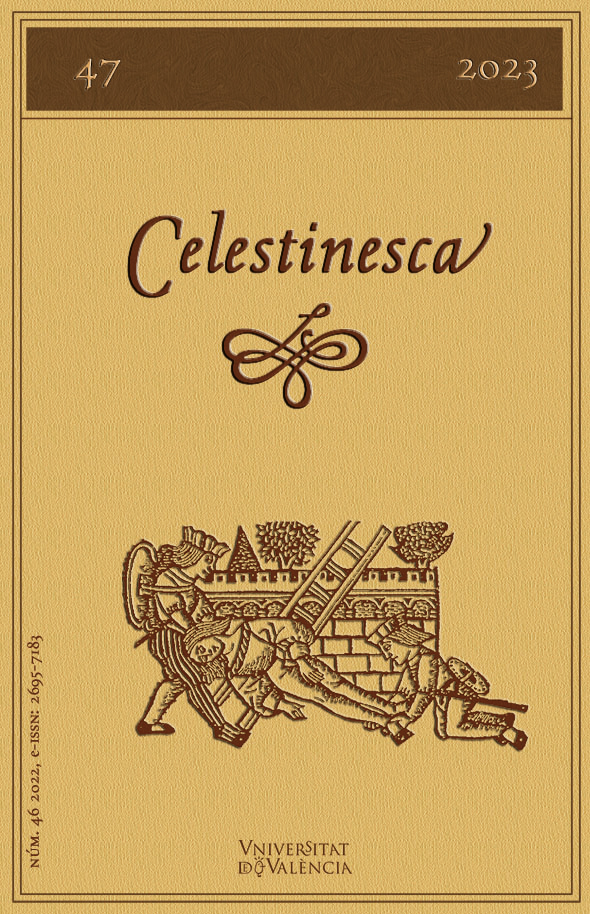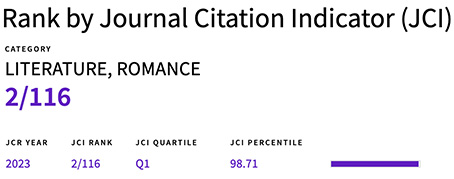«Celestina» in 21st Century Historical Fiction: «El ritual de las doncellas» (2006) by José Calvo Poyato and «En la orilla» (2016) by Rafael Chirbes
DOI:
https://doi.org/10.7203/Celestinesca.47.27515Keywords:
El ritual de las doncellas, José Calvo Poyato, En la orilla, Rafael Chirbes, Intertextuality Abstract
Abstract
The Tragicomedy of Calisto and Melibea (ca. 1502)—initially conceived as a comedy, and often identified as (La) Celestina—has never lacked readers since its composition soon before 1499. Nowadays, the bibliography on Celestina is immeasurable and its impact on theatrical performance and films quite sizeable. Furthermore, critics have started to pay attention to its influence on contemporary fiction. In this paper we analyze how two contemporary writers have interpreted and re-used Celestina in radically different manners and using disparate literary categories. Thus, on the one hand, Celestina inspires character development, plot, and historical reconstruction in El ritual de las doncellas (2006), a Baroque historical noir penned by historian José Calvo Poyato. On the other hand, for novelist Rafael Chirbes Celestina is not only a "toolbox" of techniques, scenes, and quotes useful for writers, but it also enacted a literary revolution by itself. More precisely, Celestina still embodies an ethical conception of literature according to which language becomes an instrument to reveal ideological manipulation, social corruption and the mistreatment of the vanquished in history. To sum up, by comparing José Calvo Poyato’s and Rafael Chirbes’ different visions and inconspicuous adaptations of Celestina in their novels, we can gain new insights into two intertextuality phenomena that affect popular and highbrow literature. This also reveals the literary values and creative power of this 15th century masterpiece.
 Downloads
Downloads
 References
References
Baranda, Consolación “Celestina’s Continuations, Adaptations and Influences”, en Enrique Fernández (ed.), A Companion to "Celestina". Leiden: Brill, 2017, pp. 321-338. https://doi.org/10.1163/9789004349322_021
Calvo Poyato, José, Así vivían en el Siglo de Oro. Madrid: Anaya, 1989.
Calvo Poyato, José, El ritual de las doncellas. Barcelona: Plaza Janés, 2006.
Calvo Poyato, José, Los galeones del rey, edición revisada por el autor. Barcelona: Random House Mondadori, 2009.
Chirbes, Rafael, El novelista perplejo. Barcelona: Anagrama, 2002.
Chirbes, Rafael, En la otra orilla. Barcelona: Anagrama, 2014.
Canet, José Luis, (ed.), Tragicomedia de Calisto y Melibea (La Celestina). Valencia: Revista Celestinesca, 2020.
Chirbes, Rafael, Diarios. A ratos perdidos 1 y 2. Barcelona: Anagrama, 2021.
Chirbes, Rafael, Diarios. A ratos perdidos 3 y 4. Barcelona: Anagrama, 2022.
Chirbes, Rafael, “Sin piedad ni esperanza (Revolución literaria en La Celestina)”, en Por cuenta propia. Leer y escribir. Barcelona: Anagrama, 2010, pp. 41-61.
Deyermond, Alan, The Petrarchan Sources of "La Celestina". London: Oxford University Press, 1961.
Eco, Umberto, “Diez modos de soñar la Edad Media”, en De los espejos y otros ensayos. Barcelona: Lumen, 1988, pp. 84-96.
Eco, Umberto, “The Return of the Middle Ages,” en Travels in Hyperreality. Essays, William Weaver (tr.). San Diego – New York – London: Harcourt Brace Jovanovich, 1986, pp. 61-85.
Eusebio, Carmen de, “La tensión en el lenguaje debe entenderse como tensión en el proceso de aprendizaje al que se somete al lector”, Cuadernos Hispanoamericanos, 757–758 (2013): 247–257.
Fernández, Enrique, “Preface,” en Enrique Fernández (ed.), A Companion to "Celestina". Leiden: Brill, 2017, pp. ix-x. https://doi.org/10.1163/9789004349322_001
Fichte, Joerg. “Crime Fiction Set in the Middle Ages: Historical Novel and Detective Story”, Zeitschrift für Anglistik und Amerikanistik, 53.1 (2005): 53-70. https://doi.org/10.1515/zaa.2005.53.1.53" target="_blank">https://doi.org/10.1515/zaa.2005.53.1.53
François, Jéromine. “Celestina en Hispanoamérica: la nostalgia de los buenos viejos tiempos como tópico celestinesco en Toro-Garland, Fuentes y Mosquera,” Celestinesca, 42 (2018): 143-156. https://doi.org/10.7203/Celestinesca.42.20219
García Berrio, Antonio, y Javier Huerta Calvo, Los géneros literarios: sistema e historia (Una introducción). Madrid: Catedra, 1992.
Genette, Gérard, Palimpsests. Literature in the Second Degree, Channa Newman y Claude Doubinsky (trad.). Lincoln – London: University of Nebraska Press, 1997.
González Echevarría, Roberto, “Introduction”, en Fernando de Rojas, Celestina, Roberto González Echevarría (ed.), Margaret Sayers Peden (tr.). New Haven: Yale University Press, 2009, pp. xiii-xxvii.
Herman, David, “Reviewed Work(s): Palimpsests: Literature in the Second Degree by Gérard Genette”, Modern Fiction Studies, 44:4 (1998), 1043-1048. https://doi.org/10.1353/mfs.1998.0081
Huertas Morales, Antonio. La Edad Media contemporánea. Estudio de la novela española de tema medieval (1990-2012). Vigo: Academia del Hispanismo, 2015.
Huertas Morales, Antonio, “La novela de tema medieval desde 1990” [dossier]. Asociación Hispánica de Literatura Medieval, s. a. https://www.ahlm.es/contenido/page/dossier [accedido el 10/11/2023]
Knight, Stephen, “The Golden Age”, en Martin Priestman (ed.), The Cambridge Companion to Crime Fiction. Cambridge: Cambridge University Press, 2003, pp. 77-94. https://doi.org/10.1017/CCOL0521803993.006
Lacalle, Juan Manuel. “Sobre La Edad Media contemporánea. Estudio de la novela española de tema medieval (1990-2012), de Antonio Huertas Morales”, Revista Exlibris, 8 (2019): 303-309. http://revistas.filo.uba.ar/index.php/exlibris/article/view/3276 [accedido el 10/11/2023]
Landeira, Ricardo, El género policiaco en la literatura española del siglo XIX. Alicante: Universidad de Alicante, 2001.
Lemaitre, Phillipe, Diccionario apasionado de la novela negra, José Antonio Soriano Marco (trad.). Barcelona: Salamandra, 2021.
Llamas Martínez, Jacobo, “La Celestina como modelo de Rafael Chirbes en Crematorio”, Celestinesca 44 (2020): 163-190. https://doi.org/10.7203/Celestinesca.44.19432
Márquez Villanueva, Francisco, “La Celestina como antropología hispano-semítica”, en Santiago López-Ríos (ed.), Estudios sobre "La Celestina". Madrid: Istmo, 2001, pp. 241-278.
Mena, Juan de, “Coronación”, en Obra completa, Angel Gómez Moreno y Teresa Jiménez Calvente (ed.). Madrid: Turner, 1994.
Miles, Valerie, “Afterword”, en Rafael Chirbes, On the Edge, Margaret Jull Costa (trad.). Pimlico: Vintage, 2016, pp. 411-421.
Muñoz, José Luis, “Dossier. El mundo en negro”, conferencia inaugural del Simposio de Género Negro en la Universidad Central de Bogotá, Hojas Universitarias, 59 (2007): 109-123. https://editorial.ucentral.edu.co/ojs_uc/index.php/hojasUniv/article/view/737 [accedido el 10/11/2023]
Pardo de Santayana et al., “Naturaleza a través de la botánica y zoología en la literatura renacentista española: La Celestina”, Asclepio. Revista de Historia de la Medicina y de la Ciencia, LXIII:1 (2011): 249-292. https://doi.org/10.3989/asclepio.2011.v63.i1.493
Perez-Romero, Antonio, “Modernity and Celestina: The Future of Our Past and of Our Present”, en Enrique Fernández (ed.), A Companion to "Celestina". Leiden: Brill, 2017, 275-291. https://doi.org/10.1163/9789004349322_018
Prieto de Paula, Ángel Luis, y M.ª Mar Langa Pizarro, Manual de literatura española actual: de la transición al tercer milenio. Madrid: Castalia, 2007.
Snow, Joseph, “The Significance of Celestina”, en Enrique Fernández (ed.), A Companion to "Celestina", Leiden: Brill, 2017, 3-17. https://doi.org/10.1163/9789004349322_002
Valls, Fernando, “La narrativa de Rafael Chirbes: entre las sombras de la Historia”, Turia: Revista Cultural, 112 (2014): 127-145. https://www.ieturolenses.org/revista_turia/index.php/actualidad_turia/la-narrativa-de-rafael-chirbes-entre-las-sombras-de-la-historia [accedido el 10/11/2023]
Varona, Rubén, Repensando la literatura híbrida y posmoderna: la justicia como herramienta analítica del noir histórico [tesis doctoral inédita]. Texas Tech University, 2018. http://hdl.handle.net/2346/74517
Downloads
Published
How to Cite
-
Abstract245
-
PDF (Español)284
Issue
Section
License
![]() Celestinesca is committed to the dissemination of knowledge, that is why access to its contents is free and is ruled by a Creative Commons Attribution-NonCommercial-NoDerivatives 4.0 license.
Celestinesca is committed to the dissemination of knowledge, that is why access to its contents is free and is ruled by a Creative Commons Attribution-NonCommercial-NoDerivatives 4.0 license.
Authors retain the rights to their works. Therefore, they can disseminate them and deposit them in the repository, institutional or not, that they wish. However, they are kindly requested to do so by providing the full bibliographic reference and the corresponding DOI.
Celestinesca does not charge authors for submitting, processing, reviewing or publishing their articles.





